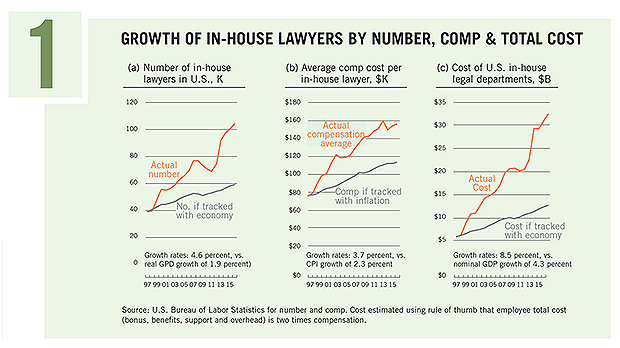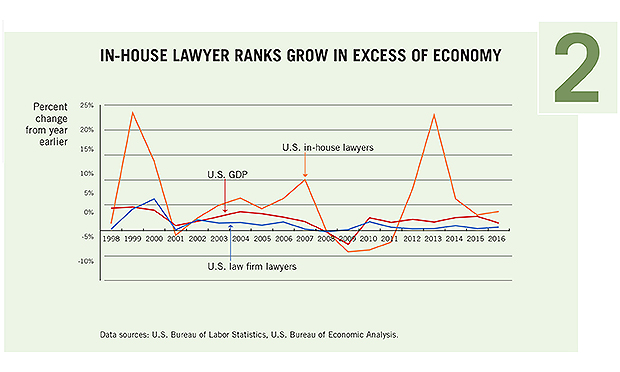The Rise (and Fall?) of In-House Counsel
Is the bubble set to burst on the buildup of law departments or is now the time to go in-house?
February 25, 2018 at 06:00 PM
12 minute read
The original version of this story was published on The American Lawyer
 Motion Graphic by Hyeon Jin Kim
Motion Graphic by Hyeon Jin Kim
DXC Technology's deal to outsource the bulk of its legal department to UnitedLex got us thinking. Is the buildup of in-house lawyers turning? Do companies no longer look at in-house lawyers as a way to save money on outside counsel but instead look at the legal department as a cost to be minimized through outsourcing?
The data suggest a more complex dynamic. Yes, the growth in the number of in-house lawyers has outpaced the broader market, as has the growth in their compensation levels, leading to swollen legal department costs. Naturally, companies are finding ways to lower this cost. Routine work was taken from Big Law and brought in-house to lower costs; now it's moving from in-house to “new law” outsourced service providers to reduce costs further.
This is only half the story. The data also show that the cost differential that drove displacement of work from Big Law to in-house has not diminished and that in-house lawyers can handle increasingly complex matters. Thus, we can expect the displacement from Big Law to in-house to continue and to center on work of greater sophistication.
With both displacements happening simultaneously, general counsel will increasingly operate ambidextrously: taking work from Big Law to execute in-house with one hand, while outsourcing work currently executed in-house to outsourced service providers with the other. This is a once-in-a-career moment for forward-thinking general counsel: push less-interesting work out, take more interesting work in, and earn plaudits from management for lowering the company's overall legal cost.
It's a less august moment for Big Law lawyers whose services aren't especially distinct from those an in-house lawyer might expect to perform. The opportunity for such struggling Big Law lawyers? Take the comp hit of moving in-house now rather than take an even bigger hit as part of the wave of partner departures that will accompany the next market downturn.
The Rise of In-House Departments
Let's start with some data on in-house lawyers. Figure 1(a) shows the actual number of in-house lawyers by year from 1997 through 2017 contrasted with the number there would have been had growth tracked that of the overall economy. The number of in-house lawyers today is almost twice what could have been expected based on economic growth.
This growth has not been smooth; rather, the year-to-year changes in the number of in-house lawyers have moved as an exaggeration of changes in real U.S. GDP, see Figure 2. This is evidence of law's strong cyclicality and an evergreen reminder that, just as the leaders of law firms during the last downturn weren't all idiots, leaders of firms enjoying today's ebullience aren't necessarily all geniuses.
This content has been archived. It is available through our partners, LexisNexis® and Bloomberg Law.
To view this content, please continue to their sites.
Not a Lexis Subscriber?
Subscribe Now
Not a Bloomberg Law Subscriber?
Subscribe Now
NOT FOR REPRINT
© 2025 ALM Global, LLC, All Rights Reserved. Request academic re-use from www.copyright.com. All other uses, submit a request to [email protected]. For more information visit Asset & Logo Licensing.
You Might Like
View All
Internal Whistleblowing Surged Globally in 2024, So Why Were US Numbers Flat?
6 minute read
Inside Track: AI Is Sure to Fray Big Law's Devotion to Billable Hour

John Deere Annual Meeting Offers Peek Into DEI Strife That Looms for Companies Nationwide
7 minute readTrending Stories
- 1E-Discovery Provider Casepoint Merges With Government Software Company OPEXUS
- 2How I Made Partner: 'Focus on Being the Best Advocate for Clients,' Says Lauren Reichardt of Cooley
- 3People in the News—Jan. 27, 2025—Barley Snyder
- 4UK Firm Womble Bond to Roll Out AI Tool Across Whole Firm
- 5Starbucks Hands New CLO Hefty Raise, Says He Fosters 'Environment of Courage and Joy'
Who Got The Work
J. Brugh Lower of Gibbons has entered an appearance for industrial equipment supplier Devco Corporation in a pending trademark infringement lawsuit. The suit, accusing the defendant of selling knock-off Graco products, was filed Dec. 18 in New Jersey District Court by Rivkin Radler on behalf of Graco Inc. and Graco Minnesota. The case, assigned to U.S. District Judge Zahid N. Quraishi, is 3:24-cv-11294, Graco Inc. et al v. Devco Corporation.
Who Got The Work
Rebecca Maller-Stein and Kent A. Yalowitz of Arnold & Porter Kaye Scholer have entered their appearances for Hanaco Venture Capital and its executives, Lior Prosor and David Frankel, in a pending securities lawsuit. The action, filed on Dec. 24 in New York Southern District Court by Zell, Aron & Co. on behalf of Goldeneye Advisors, accuses the defendants of negligently and fraudulently managing the plaintiff's $1 million investment. The case, assigned to U.S. District Judge Vernon S. Broderick, is 1:24-cv-09918, Goldeneye Advisors, LLC v. Hanaco Venture Capital, Ltd. et al.
Who Got The Work
Attorneys from A&O Shearman has stepped in as defense counsel for Toronto-Dominion Bank and other defendants in a pending securities class action. The suit, filed Dec. 11 in New York Southern District Court by Bleichmar Fonti & Auld, accuses the defendants of concealing the bank's 'pervasive' deficiencies in regards to its compliance with the Bank Secrecy Act and the quality of its anti-money laundering controls. The case, assigned to U.S. District Judge Arun Subramanian, is 1:24-cv-09445, Gonzalez v. The Toronto-Dominion Bank et al.
Who Got The Work
Crown Castle International, a Pennsylvania company providing shared communications infrastructure, has turned to Luke D. Wolf of Gordon Rees Scully Mansukhani to fend off a pending breach-of-contract lawsuit. The court action, filed Nov. 25 in Michigan Eastern District Court by Hooper Hathaway PC on behalf of The Town Residences LLC, accuses Crown Castle of failing to transfer approximately $30,000 in utility payments from T-Mobile in breach of a roof-top lease and assignment agreement. The case, assigned to U.S. District Judge Susan K. Declercq, is 2:24-cv-13131, The Town Residences LLC v. T-Mobile US, Inc. et al.
Who Got The Work
Wilfred P. Coronato and Daniel M. Schwartz of McCarter & English have stepped in as defense counsel to Electrolux Home Products Inc. in a pending product liability lawsuit. The court action, filed Nov. 26 in New York Eastern District Court by Poulos Lopiccolo PC and Nagel Rice LLP on behalf of David Stern, alleges that the defendant's refrigerators’ drawers and shelving repeatedly break and fall apart within months after purchase. The case, assigned to U.S. District Judge Joan M. Azrack, is 2:24-cv-08204, Stern v. Electrolux Home Products, Inc.
Featured Firms
Law Offices of Gary Martin Hays & Associates, P.C.
(470) 294-1674
Law Offices of Mark E. Salomone
(857) 444-6468
Smith & Hassler
(713) 739-1250









